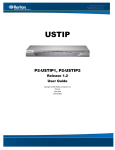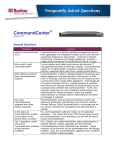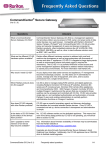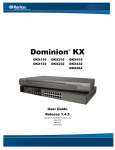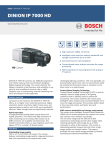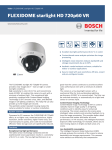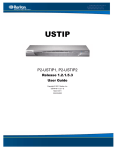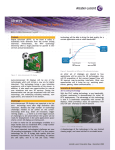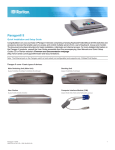Download Raritan UST-IP Setup guide
Transcript
Quick Installation and Setup Guide USTIP I. Prepare Servers and Network for Remote Operation Congratulations on your purchase of USTIP, the industry-leading solution for multi-platform, high-performance, network-based, remote KVM console access. USTIP enables highly-secure, multi-user, bandwidthefficient, and software-independent access to your servers' KVM consoles via a web browser. USTIP uses Raritan's powerful frame-grabber and Video Compression Algorithm to capture, digitize, and compress the video signal before transmitting to a remote PC. The remote user has direct access and total control of target servers for maintenance, administration, and trouble-shooting, from running GUI applications to BIOSlevel troubleshooting, and even rebooting. All Servers A. For optimal bandwidth efficiency and video performance, set the desktop background to a predominantly solid, plain, lightcolored graphic. B. Ensure that the server’s video resolution and refresh rate are supported by USTIP, and the signal is non-interlaced: Text Modes: 640x480 640x480 640x480 640x480 720x400 720x400 800x600 800x600 800x600 800x600 800x600 @ @ @ @ @ @ @ @ @ @ @ 60Hz 72Hz 75Hz 85Hz 70Hz 85Hz 56Hz 60Hz 72Hz 75Hz 85Hz 1024x768 @ 60Hz 1024x768 @ 70Hz 1024x768 @ 75Hz 1024x768 @ 85Hz 1152x864 @ 60Hz 1152x864 @ 70Hz 1152x864 @ 75Hz 1280x960 @ 60Hz 1280x1024 @ 60Hz Windows XP Disable Enhanced Pointer Precision and set the mouse motion speed exactly to the middle speed setting; these options are located in Control Panel > Mouse > Mouse Pointers. Windows 2000 / ME Set mouse pointer acceleration to none, and the mouse motion speed to the middle speed setting. Windows 95 / 98 / NT Set mouse motion speed to the slowest setting in Control Panel > Mouse > Motion. Linux Set mouse acceleration to exactly 1, and threshold to exactly 1. Sun Solaris Set mouse acceleration to exactly 1.0. Ensure that your video card is set to a supported resolution, and is outputting VGA (H-and-V Sync, not composite sync). This non-default configuration can be set in the bootprom mode by issuing the command setenv output-device screen :r1024x768x70 followed by the command boot to reboot. Macintosh No specific mouse settings are required when using USTIP to access and control a Macintosh system, but you must set the USTIP client to single cursor mode. Network / Firewall To enable USTIP, your network and firewall must allow communication on TCP Port 5000. Alternatively, USTIP can be configured to use a different TCP port of your own designation (in step II-6 below). II. Attach Local Console for Initial Configuration 1. Attach the included AC power cord to USTIP and plug the other end into a nearby AC power outlet. 2. Connect the client PC to the USTIP ADMIN Port using a serial (DB9) cable. 3. Connect a standard Ethernet cable from the Network Port to an Ethernet switch, hub, or router. 4. On a USTIP1 unit, connect the single Paragon port to the User port on your UMT unit using a CAT5 cable. On a USTIP2 unit, connect both the upper and the lower Paragon ports to User ports on your UMT unit using CAT5 cables. The upper Paragon port allows you to download the Paragon database to the USTIP unit, and the lower Paragon port allows local access to the Paragon unit. 5. Launch a Hyperterminal session from the client PC. To access the Serial Admin Port, use HyperTerminal to configure specific settings with the following steps: A. In Windows, click on the Start > Programs > Accessories > Communications, and then click HyperTerminal to start a session. B. Name the HyperTerminal session, select a session icon - if required - and then click OK. C. In the Connect To window, click on the Connect Using dropdown arrow and select COM1 (or other option, depending on where your PC's serial cable is connected) and click OK. D. In the COM1 Properties window, click on the Port Settings tab. Make sure the Bits per second drop-down is 115200 and Flow control drop-down is set to NONE, and click OK. E. On the File menu, click Properties; click on the Settings tab, then click on the Emulation drop-down arrow and select VT100. i. Click ASCII Setup and ensure that the checkbox before Wrap lines that exceed terminal width is checked and that this is the only checkbox enabled on this screen. ii. Click OK. iii. Click Terminal Setup and ensure that the checkbox before Keypad application mode is checked. iv. Click OK. 6. Power ON USTIP. 7. After booting, the USTIP Setup Wizard appears on the Admin Console screen. 6 4 UST-IP1/2 3 5 1 To AC Power Outlet 2 Press the letter B on the Admin Console keyboard to configure USTIP. 8. Navigate to the Network Configuration Screen, assign a unique name to the USTIP unit, such as its location (“ServerRoom”), and type its IP Address parameters. Press CTRL+S to save the data. 9. When the Main Menu appears, browse through the Admin Console options to configure USTIP for your environment. Please Local Port keyboard and mouse used to perform initial configuration see Raritan’s USTIP User Guide on the enclosed CDROM for detailed instructions on USTIP Configuration. 10. When you are finished configuring the USTIP unit, return to the Main Menu. Press the letter R and then press ENTER to restart the USTIP and save your changes. 11. Press the letter S and then press ENTER to shut the USTIP down, and physically power OFF the unit. III. Connect Remotely Using MPC or RRC When you complete the physical installation of your USTIP unit, access Raritan Multi-Client Platform or Raritan Remote Client and establish an initial network connection. Raritan Multi-Platform Client (MPC) and Raritan Remote Client (RRC) are graphical interfaces that allow you to remotely access the target devices connected to Raritan's Dominion, IP-Reach, and USTIP units. Note: Please see the Raritan Multi-Platform Client and Raritan Remote Client User Guide, available on Raritan's Website http://www.raritan.com/support/sup_prdmanuals.aspx, or on the Raritan User Manuals & Quick Setup Guides CD ROM, included with this shipment, for details on installing and operating MPC and RRC. Launch MPC To launch MPC from a Windows PC running Internet Explorer, type http://<IP address>/mpc into the IE address line. Please note that the MPC applet will launch in a new window that does not contain the IE Menu bar, Tool bar, Scroll bar, or Address bar. You can work in this window and toggle to other open windows using the command ALT+TAB when in a Windows environment. You can also install MPC as a standalone applet, described further in the Raritan MultiPlatform Client and Raritan Remote Client User Guide. To launch MPC from any browser except Internet Explorer running on a Windows PC, type http://<IP address> into your browser's address line, where <IP address> is the IP address of the Raritan device. 2. If you are using Windows NT, 2000, XP, or 2003, ensure that you are not a "restricted" user. 3. Launch Microsoft Internet Explorer (ensure that your Internet Explorer security settings allow the download and execution of ActiveX controls). Note: A Windows default security setting of Medium is sufficient. 4. In the URL text field of your Web browser, type the IP address you assigned earlier in Step II-8. Press ENTER. 5. After RRC launches, a device tree of all automatically detected Raritan devices found on your subnet is displayed on the left side of the screen. If you do not find your Raritan unit listed by name, create an icon manually by selecting New Profile on the Connection menu. 6 Double-click on the icon that corresponds to your Raritan unit. Note: RRC works only with MS Internet Explorer. If you are using a different Web browser, MPC will load automatically. Note: You must disable any pop-up blockers in order to launch MPC. Launch RRC 1. Log on to any Windows-based computer with network access to your Raritan devices. For more detailed instructions, please consult the User Guide found on the enclosed CD-ROM or visit www.raritan.com Rev. D April 2006 255-31-0007 Quick Installation and Setup Guide USTIP IV. Establish a Connection V. Maximize UST-IP Performance Upon launching MPC or RRC, USTIP will request your user credentials. (See Raritan’s USTIP User Guide for user account administration). Log on using Paragon’s default username and password (admin / raritan). You will immediately be connected to your USTIP unit. Use the Navigator on the left-hand side of the RRC window, to select and connect to a port. USTIP’s dynamic video compression algorithms maintain usability under varying bandwidth constraints. Unlike competitive solutions, USTIP optimizes its output for not just LAN utilization, but also via the WAN and dial-up. By adjusting color depth and limiting video output, USTIP offers the optimal balance between video quality and system responsiveness in any bandwidth constraint. Familiarize yourself with the following configurable parameters to adjust performance options even further. Note: The default username and password (admin / raritan) will work only if the Paragon unit is configured to recognize them, because USTIP authenticates off of the Paragon User Database. If your USTIP device is new but is being connected to a previously-existing Paragon setup, this default password has probably been changed. Please check with your Network Administrator for the current username and password. Please notice that the MPC and RRC screens vary only in that the MPC screen has a Message Panel in its lower left corner. The MPC Message Panel displays a simplified log of connection attempts and other significant system events. Video Smoothing Color Calibration Setting the video smoothing level too high may prohibit USTIP from correctly transmitting color gradations. On the Connection menu, click Properties and adjust the Smoothing level to an appropriate setting for your environment. Some video cards output non-standard signal levels. To optimize transmitted color for accuracy, perform a color calibration upon inital USTIP setup: Noise Filter The Navigator displays all known Raritan networked devices. Click the Synchronize Mouse tool to converge the mouse pointers displayed. The Toolbar provides single-click access to frequently-used features and commands. Double-click on a port to establish control over the server or KVM switch attached to that port. application and maximizing its window size. 2. In the RRC menu bar, on the Video menu, click Calibrate Color and adjust the color calibration for optimal viewing. 1. On the remote server desktop that you are controlling with USTIP, ensure that a solid light color covers 15% or more of the screen. We suggest opening the Notepad All video graphics cards generate electrical noise that cannot be seen by the naked eye when displayed on a monitor. USTIP reduces the bandwidth it consumes by intelligently ignoring extraneous signal noise. Setting the noise filter too high may prohibit USTIP from correctly transmitting screen changes. On the Video menu, click Video Settings and to adjust the Noise Filter level to an appropriate setting for your environment. Users with Administrator privileges may modify USTIP configuration settings remotely. Remotely access VT100 serial consoles connected to the “Serial IN” port of USTIP. The RRC Status Bar provides real-time information on connection parameters. Once connected to a port, keystrokes and video signals are transmitted in realtime, as if you were situated locally. For assistance in North or South America, please contact the Raritan Technical Support Team by telephone (732) 764-8886, by fax (732) 764-8887, or by e-mail [email protected] - Ask for Technical Support - Monday through Friday, 8:00 a.m. to 8:00 p.m., Eastern.


